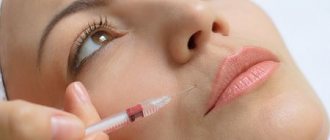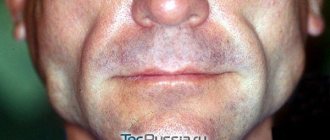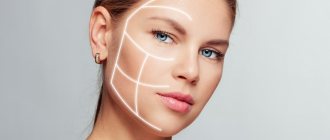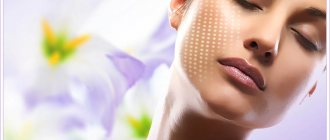How asymmetry in the eye and eyebrow area is corrected
Asymmetry less than 4 mm can be corrected with Botox. Botulinum toxin injections work especially effectively for symmetry disorders caused by injuries or the consequences of a stroke. The products last for 4-6 months, after which the injections will have to be done again.
These drugs also help with broken symmetry caused by incorrect facial expressions. In this case, botulinum toxin is an ideal correction option.
Asymmetry caused by tissue loss of volume is corrected using fillers. You need to choose medications carefully, since not all products can be used in the eye area. A good effect is achieved by modern fillers based on hyaluronic acid, which replenish large volumes of tissue and last a long time. Fillers have a limited lifespan, so they will have to be re-injected after some time.
Plastic surgery gives a lasting result that does not need to be constantly adjusted. Using a precise incision, the surgeon will remove loose skin, excess fat and tissue from the eyelids. Traces of intervention are hidden in the natural fold of the eye, so they will not be visible. The recovery period after surgery is about a week, and after 10 days the asymmetry will completely disappear.
Correcting asymmetry in the eye area with plastic surgery. Result before and after
Combined methods are used for complex cases. For example, when there is a shortage of tissue, plastic surgery is combined with fillers. In this case, you will still have to do injections after surgery. This is not even bad, since the tissues in the eye area are constantly subject to age-related changes, and fillers make it possible to correct them depending on the current condition.
Injections of filler, fillers and plastic not only eliminate asymmetry, but also remove age-related changes - crow's feet, wrinkles, dark circles around the eyes.
How facial symmetry develops
Like all vertebrates, humans have bilateral symmetry relative to the sagittal plane. For the most part, our right side develops as a mirror image of our left. Beginning in embryonic development and during growth and maturity, the same developmental genes must be activated in the same cells, at the same time. In an ideal situation, this all unfolds equally on the left and right sides of the face and results in complete symmetry between the two halves.
Nose asymmetry – fillers instead of plastic surgery
Nasal asymmetry is caused by various traumatic injuries and birth defects. Previously, patients with this feature could only be helped through plastic surgery - rhinoplasty, which is difficult to tolerate and does not always give the desired results.
Therefore, the invention of dense fillers based on hydroxyapatite and cross-linked hyaluronic acid, which change the shape of the nose without surgery, was a real event. With their help, you can remove the asymmetry of the bridge of the nose, the back of the nose, straighten its wings, and smooth out traces of injuries and operations.
However, fillers have a disadvantage - they can only add volume where it is lacking. Drugs are not able to remove excess. In this case, you will need the help of a plastic surgeon.
Surgery is performed if external asymmetry is accompanied by changes in internal structures - deviated septum, bone deformation. In this case, surgery would be the ideal choice.
Sometimes the shape of the nose becomes asymmetrical due to impaired facial expressions. Botox injections will help in this situation.
Asymmetry of the nose - fillers instead of plastic surgery. Result before and after
Fillers and Botox are inconvenient and have a limited duration. After a certain time - from 4 to 18 months, the injections will have to be repeated. Plastic surgery solves the issue radically. In addition, it makes it possible to adjust the tissue towards decreasing or increasing volume.
Therefore, the patient always needs to think carefully about which option would be most preferable for him - surgical or non-surgical. In this case, it is advisable to listen to the advice of a specialist.
Facial asymmetry
In the evolution of living matter, there is a clearly visible tendency towards a paradoxical combination of seemingly incompatible or even mutually exclusive features. Thus, in nature, geometrically ideal spirals, tree-like structures or more complex fractal forms are widely represented - but they are presented in an infinite variety of small individual errors (on the globe, out of billions of leaves on trees, not even two are identical). All higher species, including humans, are characterized by a longitudinally symmetrical morphology - but, at the same time, the anatomical structure includes both paired and unpaired organs, and the bihemispheric structure of the brain implies asymmetric functioning of the cerebral hemispheres, which interact mainly through the most complex neural plexuses of the corpus callosum. This, in particular, results in right- and left-handedness, with the hand of the dominant hand, as a rule, being better developed.
First, artists and sculptors, and then scientists, have known since time immemorial: absolutely symmetrical faces do not exist. It's all about the degree of asymmetry - in some cases it only adds charm, in others it catches the eye and is perceived as a cosmetic defect. If we talk about asymmetry of the second kind, then the reasons are very numerous. Congenital include various anomalies of intrauterine development of bone, cartilaginous, vascular and muscular-ligamentous structures of the maxillofacial region and/or cervical spine. The most common causes of acquired asymmetry include neuromuscular pathology (consequences of strokes, various neuritis, degenerative processes, injuries, etc.). Another group of causes consists of visual impairments, in particular, severe anisometropia (difference in visual acuity between the right and left eyes) or strabismus (strabismus). The third group of asymmetry factors falls within the competence of dentists and orthodontists: one-sided adentia (lack of teeth), all kinds of inflammation and destruction of dental tissues, malocclusion, consequences of surgical extraction of teeth, and many others. Finally, the cause of asymmetry may be some long-term habit - for example, smoking a pipe held only in the right or left corner, constant sly squinting of one eye, a sarcastically raised eyebrow, etc.
It is obvious that in some cases, correction of asymmetry, including surgery, is indicated and necessary, in others it is absolutely unnecessary or contraindicated. These issues should be resolved exclusively with a doctor, and whatever the specialist’s conclusion, it is worth listening to it very carefully: it is based on a much larger number of criteria, factors and nuances of a particular case than it seems from the outside of medicine.
Correcting an asymmetrical chin
The main reason for asymmetry in this area is problems with the masticatory muscle. It runs from the cheek down the outside of the chin and is present on both sides of the face.
Chin asymmetry is caused by a number of reasons:
- Genetic characteristics.
- Injuries to bones, muscles, nerves.
- Teeth grinding – bruxism.
- Dental problems. The problem often occurs when patients chew on one side of the mouth due to decayed teeth.
As a result, men and women notice that one side of the chin becomes more prominent over time. Sometimes the face becomes distorted.
Chin asymmetry can be corrected using fillers. For this purpose, preparations based on concentrated high-density hyaluronic acid are used, which make it possible to obtain a good result that lasts a long time. Asymmetry is also eliminated with fillers containing both hyaluronic acid and calcium hydroxyapatite, for example, Neauvia.
Correcting chin asymmetry with fillers. Result before and after
A double chin is often asymmetrical. In this situation, lipolytics will help - drugs that remove fat deposits, model this area and improve facial features, for example, Aqualix.
Facial asymmetry due to malocclusion: manifestations
Malocclusion (and this does not include crooked teeth, but a violation of the position of the jaws relative to each other) often leads to many problems, distorting our appearance. Among the main ones are a small or too massive chin, drooping corners of the lips, sunken cheeks, the mouth may be constantly slightly open.
Facial asymmetry also occurs - an incorrect bite affects the position of the jaws relative to each other. In this situation, we are talking about a crossbite, in which the lower jaw is displaced laterally relative to the upper jaw. This breaks the symmetry of our face. In addition to the obvious aesthetic problems, this disease also threatens with physiological complications.
How to independently identify asymmetry
The violation can also be determined in home or other comfortable conditions for a person. To do this, you need to take a passport photo. There is no need to smile or squint your eyes.
Then you need to analyze the resulting photograph. To do this, use a ruler to draw a horizontal line along the pupils, lips and eyebrows. It is recommended to start with the eyes. This is due to the fact that the human internal level tends to the horizon precisely in their zone. Nature designed it this way so that people can walk smoothly and not fall.
If any part of the face is higher or lower than the same area on the opposite side by less than 3 mm, there is no cause for concern. This is a physiological norm; this disorder does not require correction. If you wish, you can contact a cosmetologist. The specialist will individually select the most suitable procedures.
If the disproportion indicator is more than 3 mm (or 5 degrees), it is recommended to consult a neurologist to exclude the development of serious pathologies. This specialist will also tell you how to achieve facial symmetry. If necessary, he will arrange a referral to a surgeon.
Gymnastics
Exercises for facial symmetry are indicated for individuals with both congenital and acquired disproportion. According to medical reviews, gymnastics in some cases can even be considered as an alternative to surgical treatment. This is due to its high degree of efficiency.
However, it is important to know that gymnastics does not always help with facial asymmetry. It will not be possible to correct the disproportion with exercises if the disorder is a consequence of bone and other pathological deformations, and also if it develops against the background of neuritis that appeared a long time ago.
In other cases, gymnastics is indicated. How to remove facial asymmetry (set of exercises):
- Place your palm on the healthy part. Fingers should be pointing upward. Then you need to put the back of your hand on the affected part. After this, you need to carefully pull the skin from the healthy side up and towards the diseased area. The movements should be massaging.
- Close eyes. Press your eyelids with your middle fingers. Make circular movements, lightly pressing on the eye muscles. The healthy part must be massaged from top to bottom, the affected part - from bottom to top.
- Place your index fingers on the wings of your nose. Then you need to stroke the healthy area from top to bottom, the affected area towards the upper part of the face.
- Place the middle finger of one hand on the nasolabial triangle, and the other under the lip. Healthy muscles must be carefully pulled down, damaged ones - up.
- Place the middle and index fingers above each eyebrow strictly in the center. Then you need to use circular massaging movements to move healthy muscles down, sick muscles to the center and up.
It is important to do gymnastics daily. Each exercise should take 10 minutes. Upon completion of the complex, the facial muscles should be symmetrical. At the initial stages of treatment, this effect persists for a short period. Over time, the results improve.
Doctors have developed a separate set of exercises for patients with neuritis. To make your face symmetrical, you need to do them daily:
- Close your eyes tightly. Duration - 10 seconds.
- Slowly frown your eyebrows. Then raise them as high as possible along with the eyelids.
- Place your fingers on the wings of your nose. When inhaling, you need to press on them.
- Slowly inflate and lift the wings of the nose.
- Stretch your lips in a smile, exposing as many teeth as possible.
- Take a deep breath, puff out your cheeks and hold the air inside for 10 seconds.
- With your lips stretched, pronounce the sound “eeee”.
- Open your mouth slightly and curl your tongue into a tube. Take a deep breath.
- Make circular movements with your tongue between your cheeks and teeth.
Exercises must be done daily for six months. If after 6 months the facial asymmetry is still noticeable, you cannot do without the help of a surgeon. This is due to the fact that the disproportion can be a consequence of atrophy not only of the nerve, but also of the muscle.
Types of imbalance
First of all, facial expression disorders are a consequence of the lack of symmetry in the hemispheres of the brain. Each of them regulates sensations and motor skills in different ways. Based on this, doctors have compiled a unified classification of disorders, which is used not only in neurology, but also in plastic surgery and cosmetology.
Types of asymmetry:
- Static (morphological). At rest, you can notice the difference between some elements. The causes may be developmental anomalies, injuries, pathologies of muscle and bone structures, as well as previous diseases.
- Dynamic (functional). Asynchronous muscle contractions appear only during facial expressions. For example, asymmetry that is absent at rest occurs when smiling. In most cases, the cause is neurological disorders.
The type of disproportion and the degree of its severity are of decisive importance when choosing treatment tactics.











